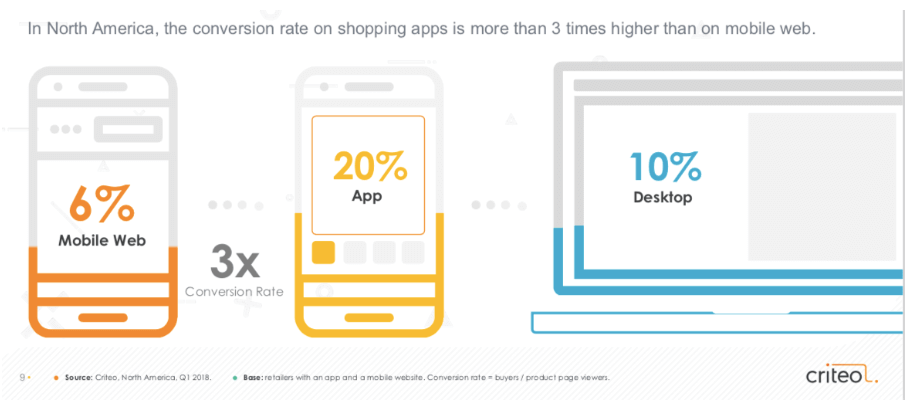eCommerce Trends & Stats to Help You Get Ahead

The world of eCommerce is HUGE — and that’s no exaggeration. Let’s take a look at the numbers for 2019:
- It’s predicted that by the end of the year, there will be 1.92 billion global digital buyers.
- eCommerce sales will account for 13.7% of total retail sales and will grow to 17.5% by 2021.
- 65% of in-store shoppers will look up price comparisons on their mobile phone.
More and more online shops are opening up and dreaming of claiming their slice of the eCommerce pie. However, the reality is that not everyone will make it big.
So, how can you make sure your eCommerce store prospers?
You have to look at the major eCommerce trends and stats and prepare. Start making some changes now to accommodate the direction things are heading.
To help you get started strong, we’ve compiled this list of some of the prevalent trends. We’ll show you how they might impact your business.
eCommerce Trends & Stats in 2019
Technology partners like Shopify have made it so simple to get a basic eStore up and running that everyone is doing it. However, just building a store isn’t enough. It’s virtually impossible to succeed in eCommerce without having a solid plan.
So many stores launch without a plan that studies show 8 out of 10 new eCommerce stores actually fail in the first 24 months.
The reasons for why this happens can vary from essentials like not having a quality website to people just not connecting with your product or brand. Some of these issues can be avoided if you look at how the industry is shaping up in the future. Here are the top eCommerce trends you should know about.
1. ‘Sites’ and ‘Apps’ Will No Longer Be Two Different Entities
PWAs (or Progressive Web Apps) could soon become the new standard for eCommerce retailers. PWAs were created by Google with the goal of delivering a native app-like experience for a user on the internet by combining the best parts of an app with the functionality of a website.
A user can navigate to a PWA in a browser just like a website. Their experience will be similar to an app, but they won’t have to download or install anything from an app store.
PWAs are faster, can be used offline — to a certain extent, allow push notifications, and the technological capabilities are still growing. Currently, the biggest disadvantage is that PWAs don’t have a search presence and won’t be ranked by Google. So, you will need to maintain your current responsive eCommerce site for marketing.
“PWAs currently don’t have any advantage in Google Search and as far as I know, there are no plans to change this.” – John Mueller, Google
PWAs do offer your customers a fast and easy mobile shopping experience. Research has shown that the conversion rate of native apps is about 3 times higher than for responsive websites.

2. Direct Selling on Social Media is Growing
It’s no doubt that social media is a major source of new customers for most online retailers.
- 30% of online shoppers have said that they would make a purchase from a social network like Pinterest, Facebook, Instagram, or Twitter
- In the US, 84% of online shoppers will review at least one social media site before making a purchase in your store.
- 85% of eCommerce orders from social media channels come from Facebook.
- Business Insider says that 500 of the top online retailers have earned roughly $6.5 billion in 2017 from social shopping — and that this was a 24% year-over-year increase.
Right now, you probably use social media to promote links to your online store and get people to visit your pages — but you can do more than that.
 Social media platforms like Facebook and Instagram have already made it possible for customers to purchase directly through their platform.
Social media platforms like Facebook and Instagram have already made it possible for customers to purchase directly through their platform.
For example, take a look at Instagram’s shoppable posts. You can quickly post and tag images with your products to make it easier for customers to buy.
Shopify also makes it easy for you to sell your products on Facebook using their Facebook Sales Channel.
Enabling this feature makes it simple for users to shop your store directly on your Facebook page.
3. AI is Already Transforming Shopping
When most people think of AI’s role in the shopping experience, we tend to think of it as a future trend that’s on the horizon, but not making a splash now.
Nothing could be further from the truth.
Artificial Intelligence is already hard at work in online stores and its role is expected to continue to grow.
Shopify even has its own AI to help you with your marketing. Her name is Kit and her goal is to be your first virtual employee. She helps you run ads, automate tasks, and get more done by simply sending your messages.
Businesses that have used Kit have mostly good things to say (878 out of 1206 reviews were 5 stars at the time this article was written):
- “We’ve been using Kit for over a year and find it is somewhat of a secret weapon for so much profitability. We have used it exclusively so far for abandoned cart and as we write this, the ROAS if 5.20!” — Atomic Jane Clothing, May 2019
- “Love Kit! I thought I had the Facebook ads down and was bringing in a good amount of traffic in from them, but boy was I wrong. I decided to try Kit for the heck of it and WOW! I’ve already had orders and my traffic has increased significantly because of this app.” — Mokolo Jewelry Co, May 2019
- “Really useful app. Kit saves a lot of my time when he is advertising by himself. Recommended for everyone who have online business.” — GS Dog Planet, May 2019
- “Kit makes some of the most difficult eCommerce tasks and simplifies them enough for everyone to be able to keep up with the competition. I am able to run retargeting facebook ads, thank new and returning customers via email, and keep up with my store’s performance all from my phone and the automated kit assistant (bot).” — SAS Shoes – New Orleans, March 2019
AI is predicted to continue to have an impact on shopping. From chatbots to product recommendations, computer-based intelligence is gearing up to help you create a personalized shopping experience for your guests.
4. ‘Green’ and ‘Socially-Conscious’ are Mandatory
There are a variety of issues plaguing our planet. Oceans are dying, the Earth is warming, human rights are being violated — and people want to help. One of the simplest ways for someone to contribute to the betterment of a cause is by purchasing something they need or want from a company that’s committed to giving back.
Social awareness is driving more and more people to want to buy from socially-conscious companies and brands.
Initially, the only companies in this category were ones that were passionate and willing to sacrifice profits if it meant that they would make an impact on a major issue. Those companies could use this passion and drive to connect with an audience and build a community around their brand.
- Google achieved its 100% renewable energy target in 2017 and is now the largest corporate renewable energy purchaser on the planet.
- Ben & Jerry’s first opposed Recombinant Bovine Growth Hormone use in cows in 1989.
- Warby Parker helps provide eyewear to people in developing countries through their Buy-A-Pair, Give-A-Pair Program.
Now, companies simply can’t afford to ignore these issues — even if they don’t have a desire to participate.
- Victoria’s Secret is having to close dozens of stores after failing to include plus-size and transgender women.
- Volkswagen claimed to be a green industry leader, but their lies were exposed and it hurt their business.
Some companies realized their mistakes, owned them, and grew a loyal following.
- Starbucks realized the impact that plastic straws are having on our oceans and marine life, and they’ve committed to eliminating plastic straws globally in their stores by 2020.
- Nike was confronted about the working conditions in their Asian factories and addressed the problems.
- The LEGO Group was pressured by Greenpeace in 2014 to end their 50-year partnership with Shell Global. Their dedication to social impact prevailed and they now rank second for Reputation Institute’s RepTrack 100.
- Levi Strauss realized that their jeans — the ones they’ve made since 1873 — are contributing to water scarcity. They launched their Water<Less campaign, dedicated to reducing their water consumption during production.
If you want to avoid a store-closing PR disaster, get ahead of social issues and know where you stand.
Do You Want to Grow Your Business in 2019?
‘But Ryan, how do these eCommerce trends affect me?’ So glad you asked.
These trends show you where eCommerce is changing and what’s coming up ahead. Your competition is fierce and widespread — so you need every advantage you can to set yourself apart and grow your business.
In 2019, there are certain standards online stores have to live up to, and while a lot of these changes might be difficult to make on your own.
The good news is that you don’t have to do them alone. Our team of skilled Shopify developers and branding experts know what it takes to keep you ahead of the curve.
You can book a meeting with me and we can talk about your future.

 Ryan Kodzik
Ryan Kodzik 
